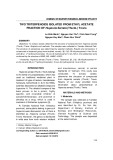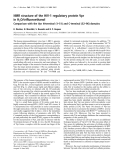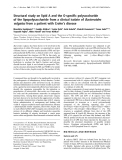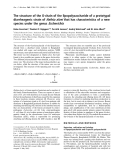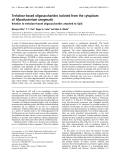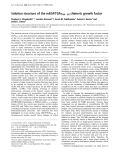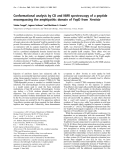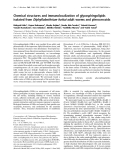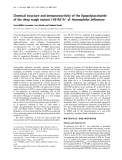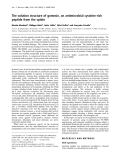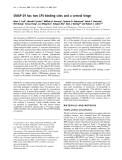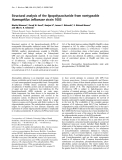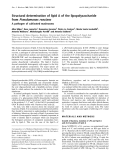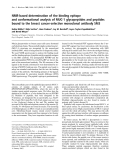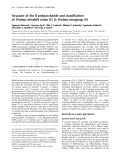
The structure of NMR
-
Phytochemical study of Knema saxatilis stems led to the isolation of six known compounds. Their chemical structures were determined as 8-hydroxy eriodictyol (1), (2S)-7-hydroxy-3′,4′-methylenedioxideflavan (2), sitostenone (3), protocatechuic acid (4), 4-hydroxybenzoic acid (5) and vanillin (6) using NMR and MS spectral data.
 7p
7p  viyoko
viyoko
 01-10-2024
01-10-2024
 2
2
 1
1
 Download
Download
-
To study relation of molecular structural changing between polypropylene microcomposite system and the particle fillers with varies phase interactions by using solid-state NMR(ssNMR) spectra.Therein,emphasizing the molecular flexibility on mechanical properties of materials.
 22p
22p  capheviahe27
capheviahe27
 23-02-2021
23-02-2021
 13
13
 2
2
 Download
Download
-
To extract, isolate, determine the structure of compounds from Huperzia serrata (Thunb.) Trevis. Subjects and methods: The samples were collected in Tamdao National Park. The structure of substances was determined by spectral methods. Results and conclusions: 2 compounds of terpenoid group were isolated, namely: 3β, 21β, 29-trihydroxyserrat-14-en-24-oic acid-3β-yl- (7’-hydroxycinnamate); 16-oxo-3α-hydroxyserrat-14-en-21β-ol, the substances were confirmed by the structure of NMR, MS, HMBC, HSQC.
 5p
5p  chauchaungayxua1
chauchaungayxua1
 02-12-2019
02-12-2019
 12
12
 1
1
 Download
Download
-
The human immunodeficiency virus type 1, HIV-1, genome encodes a highly conserved regulatory gene product, Vpr (96 amino acids), which is incorporated into virions in quantities equivalent to those of the viral Gag protein. In infected cells, Vpr is believed to function during the early stages of HIV-1 replication (such as transcription of the proviral genome and migration of preintegration nuclear complex), blocks cells in G2 phase and triggers apoptosis.
 10p
10p  system191
system191
 01-06-2013
01-06-2013
 47
47
 4
4
 Download
Download
-
Bacteroides vulgatus has been shown to be involved in the aggravation of colitis. Previously, we separated two potent virulence factors, capsular polysaccharide (CPS) and lipopolysaccharide (LPS), from a clinical isolate of B. vulgatus and characterized the structure of CPS. In this study, we elucidated the structures of O-antigen polysaccharide (OPS) and lipid A in the LPS. LPS was subjected to weak acid hydrolysis to produce the lipid A fraction and polysaccharide fraction.
 7p
7p  system191
system191
 01-06-2013
01-06-2013
 59
59
 8
8
 Download
Download
-
The structure of the O-polysaccharide of the lipopolysaccharide from a diarrheal strain isolated in Bangladesh was studied with sugar, and methylation analysis, NMR spectroscopy, mass spectrometry and partial acid hydrolysis. The strain was first designated as Hafnia alvei, but later found to be a possible new species in the genus Escherichia. Two different polysaccharides were detected, a major and a minor one. The structure of the major polysaccharide is given below, while the structure of the minor one was not investigated. ...
 7p
7p  system191
system191
 01-06-2013
01-06-2013
 36
36
 6
6
 Download
Download
-
A series of trehalose-based oligosaccharides were isolated from the cytoplasmic fraction of Mycobacterium smegmatis and purified by gel-filtration and paper chromatography and TLC. Their structures were determined by HPLC and GLC to determine sugar composition and ratios, MALDI-TOF MS to measure molecular mass, methylation analysis to determine linkages, 1H-NMR to obtain anomeric configurations of glycosidic linkages, and exoglycosidase digestions followed by TLC to determine sequences and anomeric configurations of the monosaccharides....
 8p
8p  system191
system191
 01-06-2013
01-06-2013
 37
37
 5
5
 Download
Download
-
The solution structure of the growth factor chimera mEGF/ TGFa44250 has been determined using an extended version of the DYANA procedure for calculating structures from NMR data. The backbone fold and preferred orientation of the domains of the chimera are similar to those found in previous studies of EGF structures, and several H-bonds used as input constraints in those studies were found independently in the chimera. This shows that the modified activity of the chimera does not result from a major structural change.
 9p
9p  system191
system191
 01-06-2013
01-06-2013
 48
48
 4
4
 Download
Download
-
To establish an infection, Yersinia pseudotuberculosis utilizes a plasmid-encoded type III secretion machine that permits the translocation of several anti-host factors into the cytosol of target eukaryotic cells. Secreted YopD is essential for this process. Pre-secretory stabilization of YopD is mediated by an interaction with its cognate chaperone, LcrH. YopD possesses LcrH binding domains located in the N-terminus and in a predicted amphipathic domain located near the C-terminus. This latter domain is also critical for Yersinia virulence. ...
 10p
10p  research12
research12
 01-06-2013
01-06-2013
 51
51
 3
3
 Download
Download
-
Glycosphingolipids (GSLs) were purified from adults and plerocercoids of the tapeworm Diphyllobothrium hottai, and their chemical structures were determined. Total lipid fractions prepared from chloroform/methanol extracts of whole tissues were fractionated successively on ion-exchange chromatography, silicic acid column chromatography, and preparative TLC. The purified GSLs were characterized by methylation analysis, TLC-immunostaining, liquid secondary ion MS, MALDI-TOF MS, and 1H-NMR.
 11p
11p  research12
research12
 01-06-2013
01-06-2013
 42
42
 4
4
 Download
Download
-
The structure of the lipopolysaccharide (LPS) of Pseudomonas aeruginosa immunotype 1 was studied after mild acid and strong alkaline degradations by MS and NMR spectroscopy. Three types of LPS molecules were found, including those with an unsubstituted glycoform 1 core (A) or an isomeric glycoform 2 core substituted with one O-polysaccharide repeating unit (B) or with a long-chain O-polysaccharide. Therefore, of two core glycoforms, only glycoform 2 accepts the O-polysaccharide. LPS molecules, an O-acetyl group is present in the outer core region at unknown position....
 10p
10p  research12
research12
 01-06-2013
01-06-2013
 38
38
 4
4
 Download
Download
-
Báo cáo Y học: Solution structure of a hydrophobic analogue of the winter flounder antifreeze protein
The solution structure of a synthetic mutant type I antifreeze protein (AFP I) was determined in aqueous solution at pH 7.0 using nuclear magnetic resonance (NMR) spectroscopy. The mutations comprised the replacement of the four Thr residues by Val and the introduction of two additional Lys-Glu salt bridges. The antifreeze activity of this mutant peptide, VVVV2KE, has been previously shown to be similar to that of the wild type protein, HPLC6 (defined here as TTTT).
 8p
8p  research12
research12
 01-06-2013
01-06-2013
 38
38
 4
4
 Download
Download
-
From the lipopolysaccharide of the deep rough mutant I-69 Rd–/b+ of Haemophilus influenzae two oligosaccharides were obtained after de-O-acylation and separation by high-performance anion exchange chromatography. Their chemical structures were determined by one- and two-dimensional 1H-, 13C- and 31P-NMR spectroscopy as aKdo-4P-(2 fi 6)-bGlcN-4P-(1 fi 6)-aGlcN-1P and aKdo-5P-(2 fi 6)-bGlcN-4P-(1 fi 6)-aGlcN-1P.
 6p
6p  research12
research12
 01-06-2013
01-06-2013
 33
33
 4
4
 Download
Download
-
Gomesin is the first peptide isolated from spider exhibiting antimicrobial activities. This highly cationic peptide is composed of 18 amino-acid residues including four cysteines forming two disulfide linkages. The solution structure of gomesin has been determined using proton two-dimensional NMR (2D-NMR) and restrained molecular dynamics calculations. The global fold of gomesin consists in a wellresolved two-stranded antiparallel b sheet connected by a noncanonical b turn.
 9p
9p  research12
research12
 01-06-2013
01-06-2013
 42
42
 3
3
 Download
Download
-
The CD spectra of SMAP-29, an antimicrobial peptide from sheep, showed disordered structure in aqueous buffers, and significant helicity in membrane-like environments, including SDS micelles, lipopolysaccharide (LPS) dispersions, and trifluoroethanol buffer systems. A structure determined by NMR in 40% perdeuterated trifluoroethanol indicated that residues 8–17 were helical, residues 18–19 formed a hinge, and residues 20–28 formed an ordered, hydrophobic segment.
 9p
9p  research12
research12
 01-06-2013
01-06-2013
 37
37
 4
4
 Download
Download
-
Structural analysis of the lipopolysaccharide (LPS) of nontypeableHaemophilus in¯uenzaestrain 1003 has been achieved by the application of high-®eld NMR techniques, ESI-MS, capillary electrophoresis coupled to ESI-MS, composition and linkage analyses on O-deacylated LPS and core oligosaccharide material. It was found that the LPS contains the common structural element of H.
 11p
11p  research12
research12
 01-06-2013
01-06-2013
 47
47
 7
7
 Download
Download
-
Fructose 2,6-bisphosphate (Fru-2,6-P2 ) plays an important role in the regulation of major carbohydrate fluxes as both allosteric activator and inhibitor of target enzymes. To examine the role of Fru-2,6-P2in the regulation of hepatic carbohydrate metabolism in vivo,Fru-2,6-P2 levels were elevated in ADM mice with adenovirus-mediated overex-pression of a double mutant bifunctional enzyme, 6-phos-phofructo-2-kinase/fructose-2,6-bisphosphatase (n¼6), in comparison to normal control mice (control,n¼6). ...
 9p
9p  research12
research12
 29-04-2013
29-04-2013
 51
51
 5
5
 Download
Download
-
The chemical structure of lipid A from the lipopolysaccha-ride of the mushroom-associated bacterium Pseudomonas reactans,a pathogen of cultivated mushroom, was elucida-ted by compositional analysis and spectroscopic methods (MALDI-TOF and two-dimensional NMR). The sugar backbone was composed of theb-(1¢fi6)-linkedD-gluco-samine disaccharide 1-phosphate.
 8p
8p  research12
research12
 29-04-2013
29-04-2013
 47
47
 3
3
 Download
Download
-
Mucin glycoproteins on breast cancer cells carry shortened carbohydrate chains. These partially deglycosylatedmucin 1 (MUC-1) structures are recognized by the monoclonal antibody SM3, which is being tested for its diagnostic utility. We used NMR spectroscopy to analyze the binding mode and thebindingepitopeof peptideandglycopeptideantigens to the SM3 antibody. The pentapeptide PDTRP and the glycopentapeptide PDT(O-a-D-GalNAc)RP are known lig-ands of the monoclonal antibody.
 12p
12p  research12
research12
 29-04-2013
29-04-2013
 43
43
 3
3
 Download
Download
-
TheO-chainpolysaccharide of the lipopolysaccharide (LPS) of a previously nonclassi®ed strain ofProteus mirabilis termed G1 was studied by sugar analysis and 1 Hand13 C NMR spectroscopy, including 2D COSY, TOCSY, rota-ting-frameNOE(ROESY),H-detected 1 H, 13 CHMQC,and heteronuclear multiple-bond correlation (HMBC) experi-ments.
 7p
7p  research12
research12
 29-04-2013
29-04-2013
 51
51
 5
5
 Download
Download
CHỦ ĐỀ BẠN MUỐN TÌM










